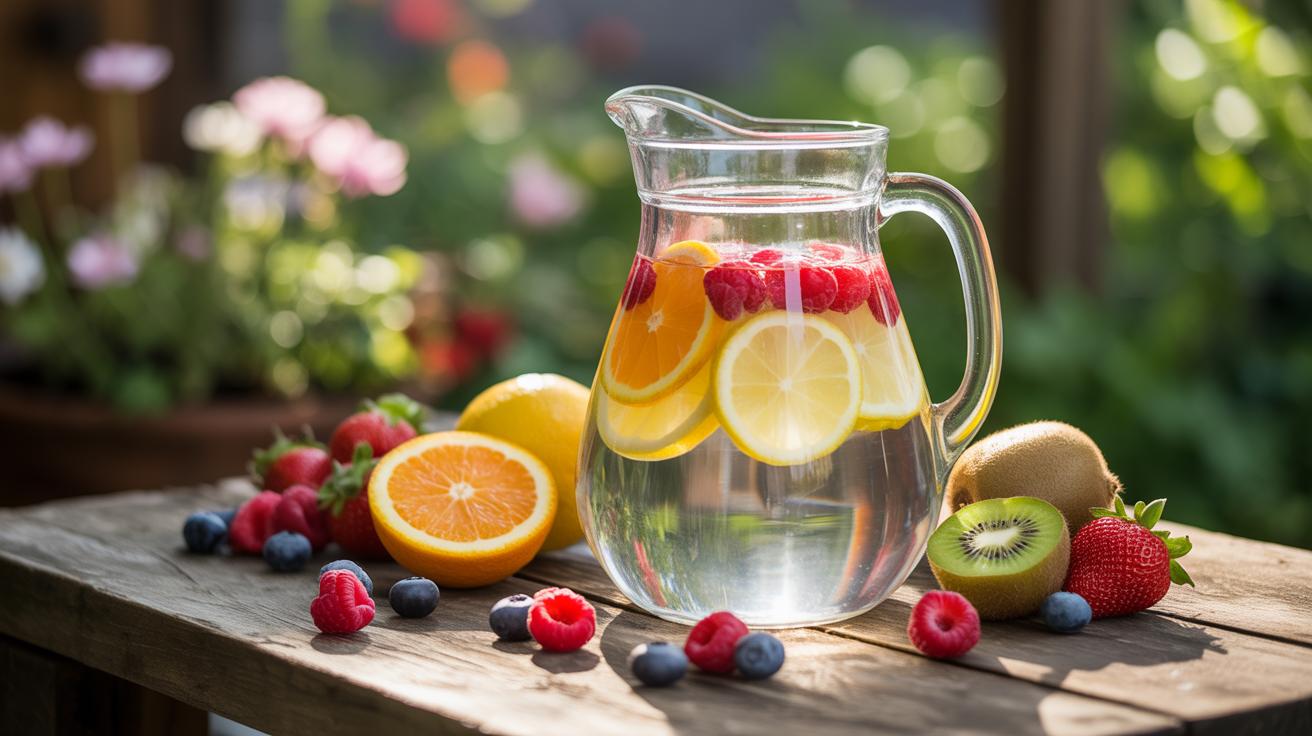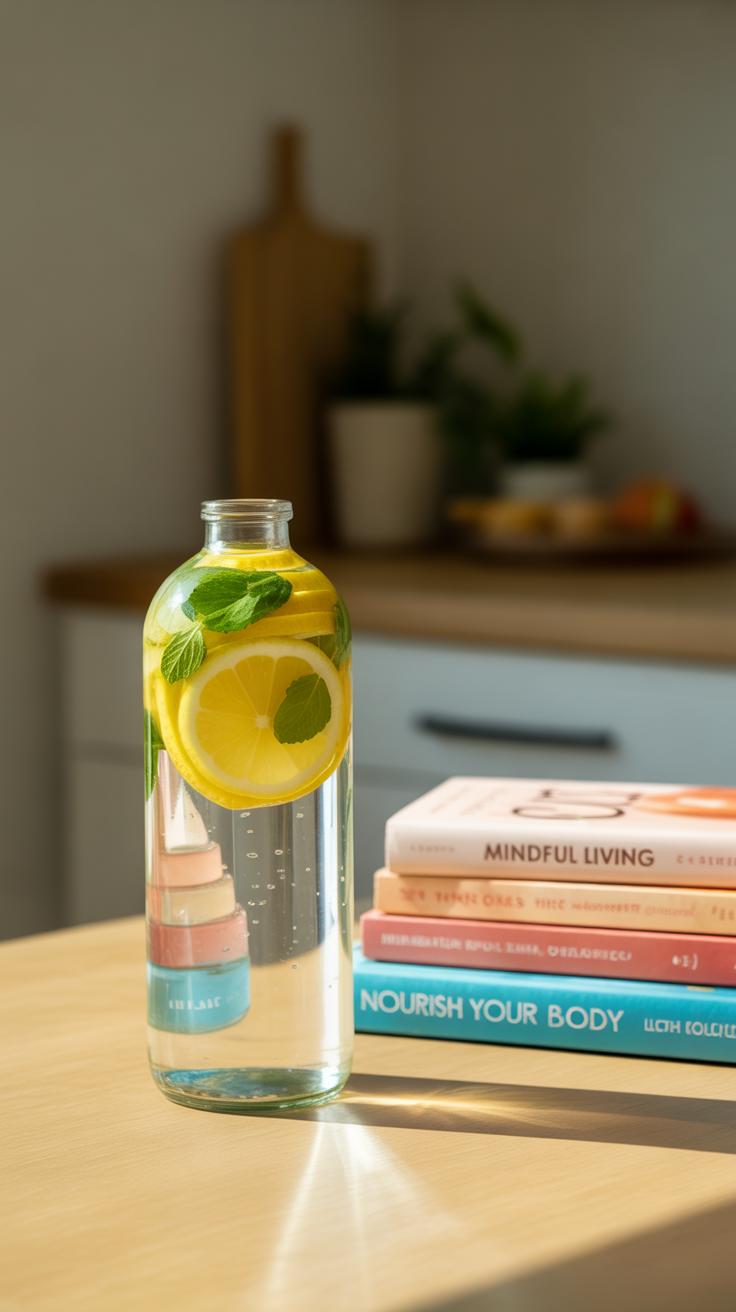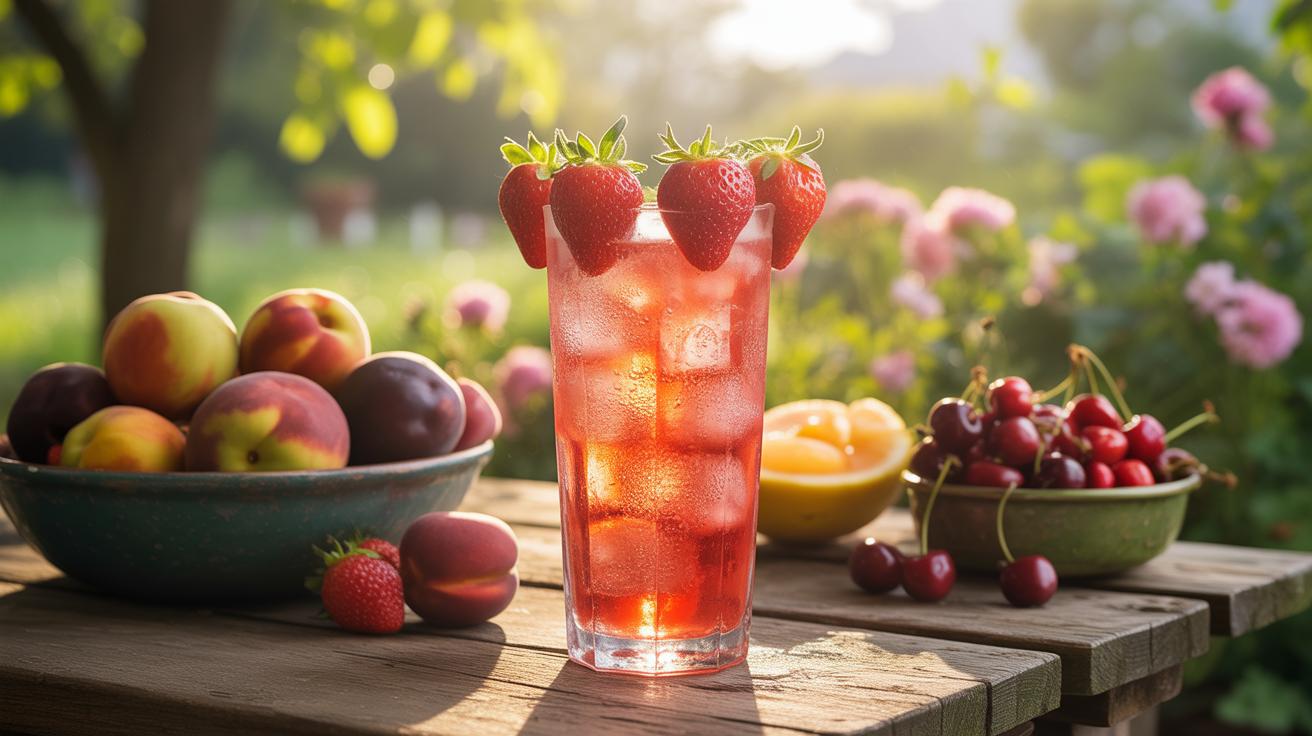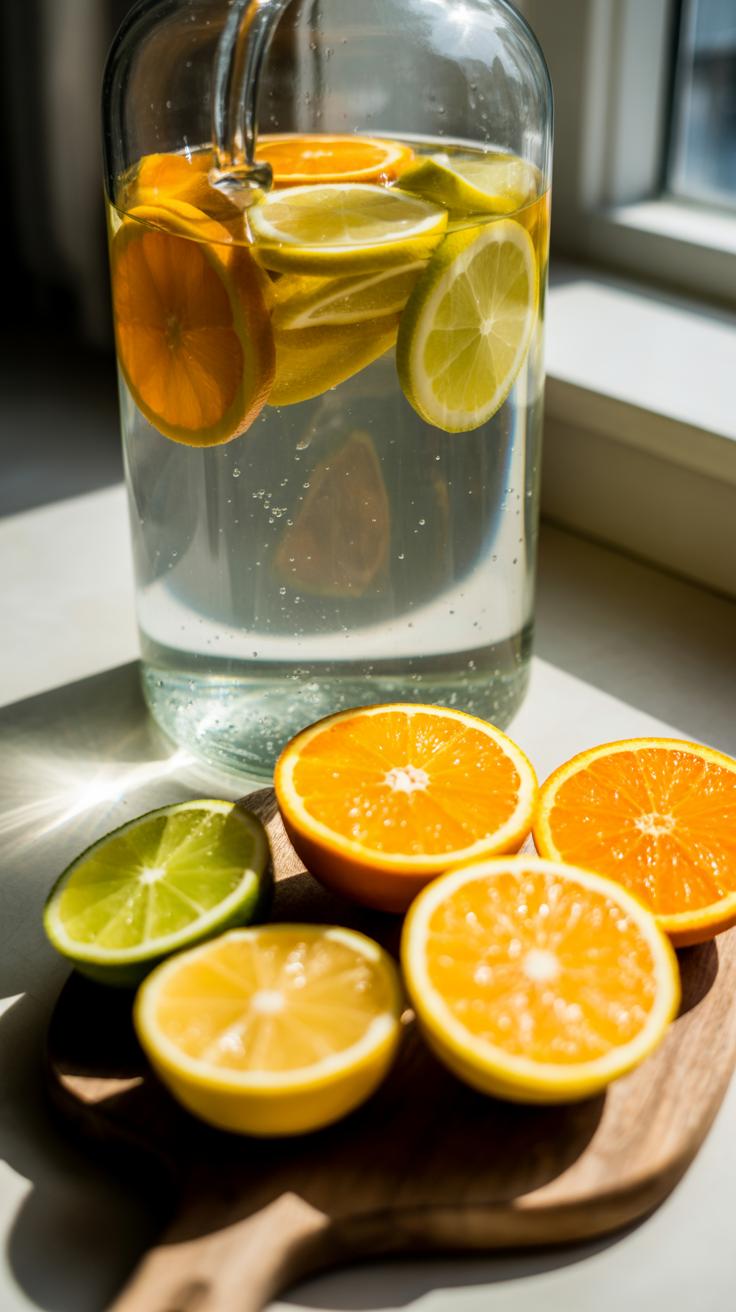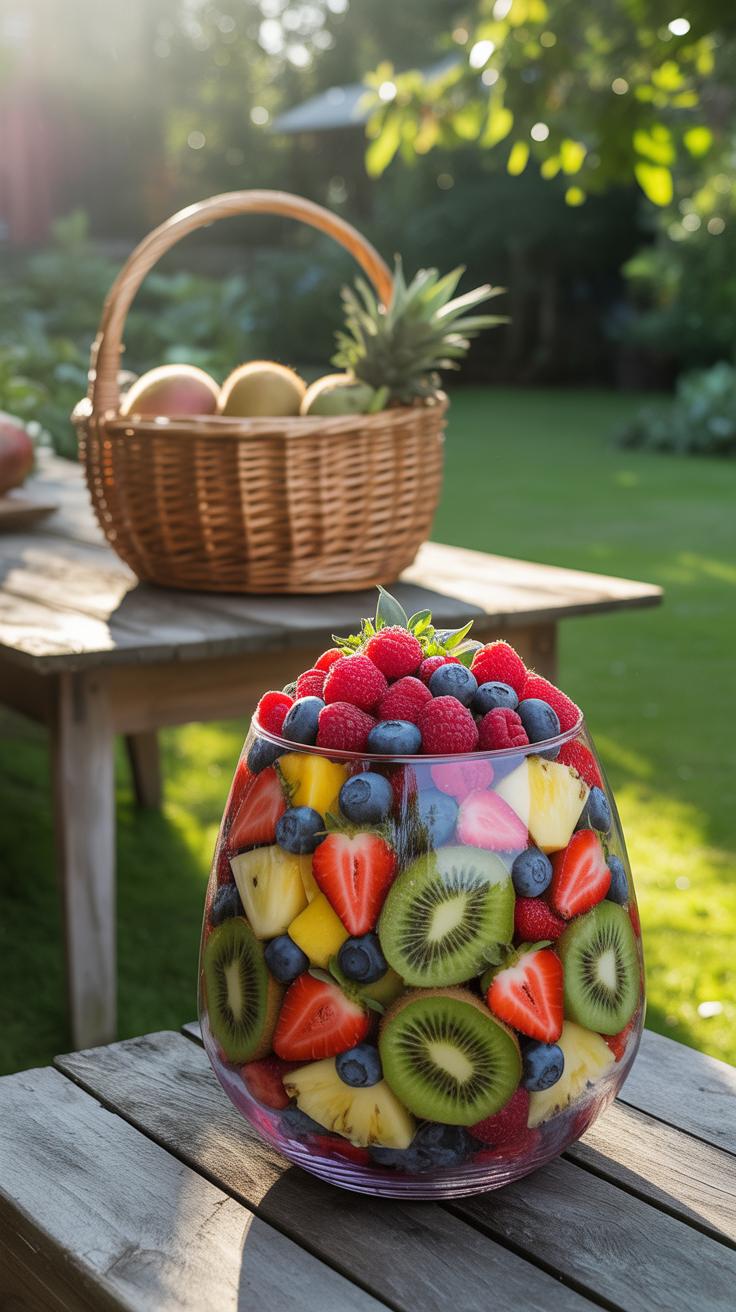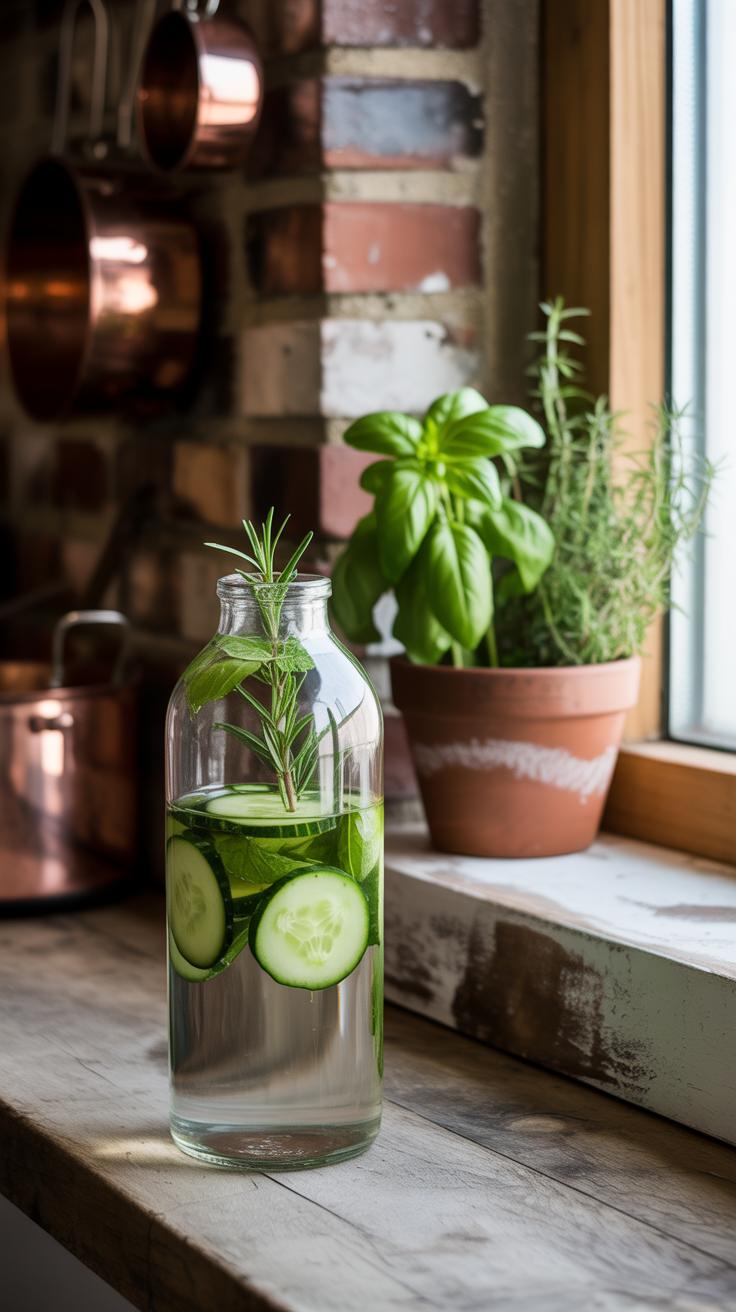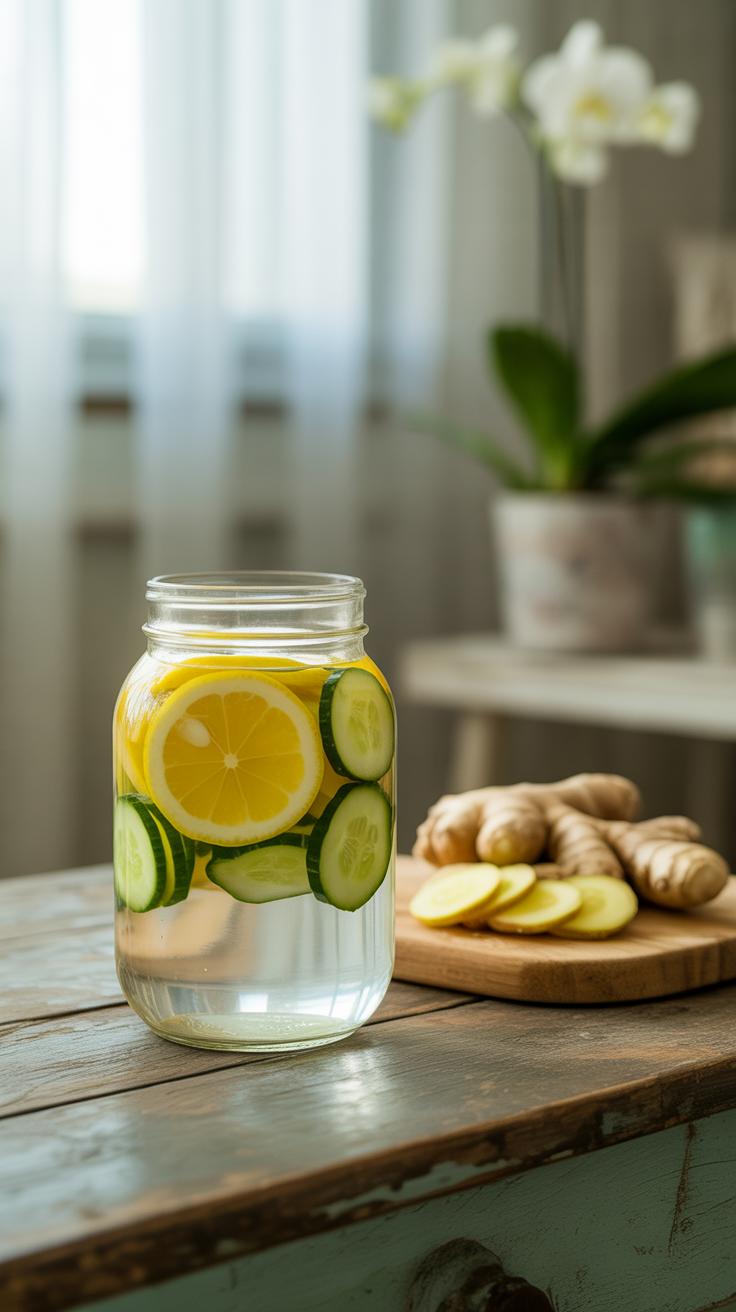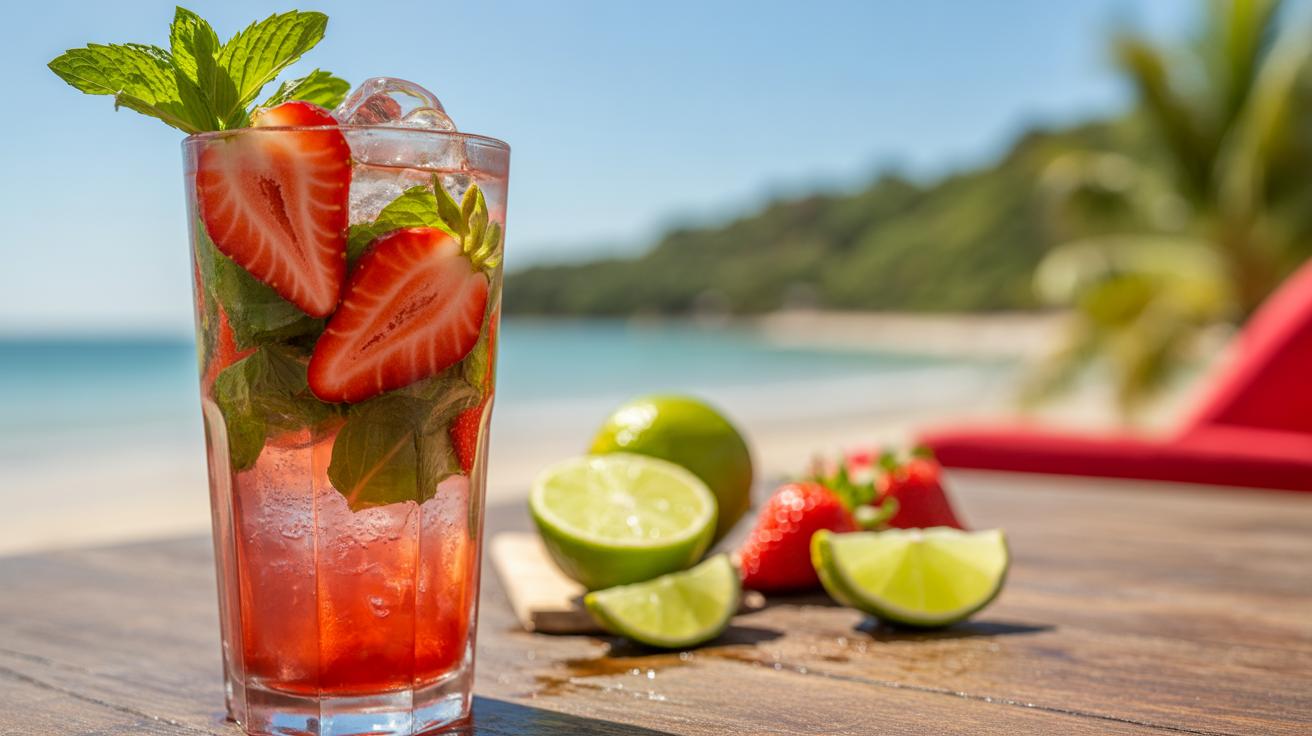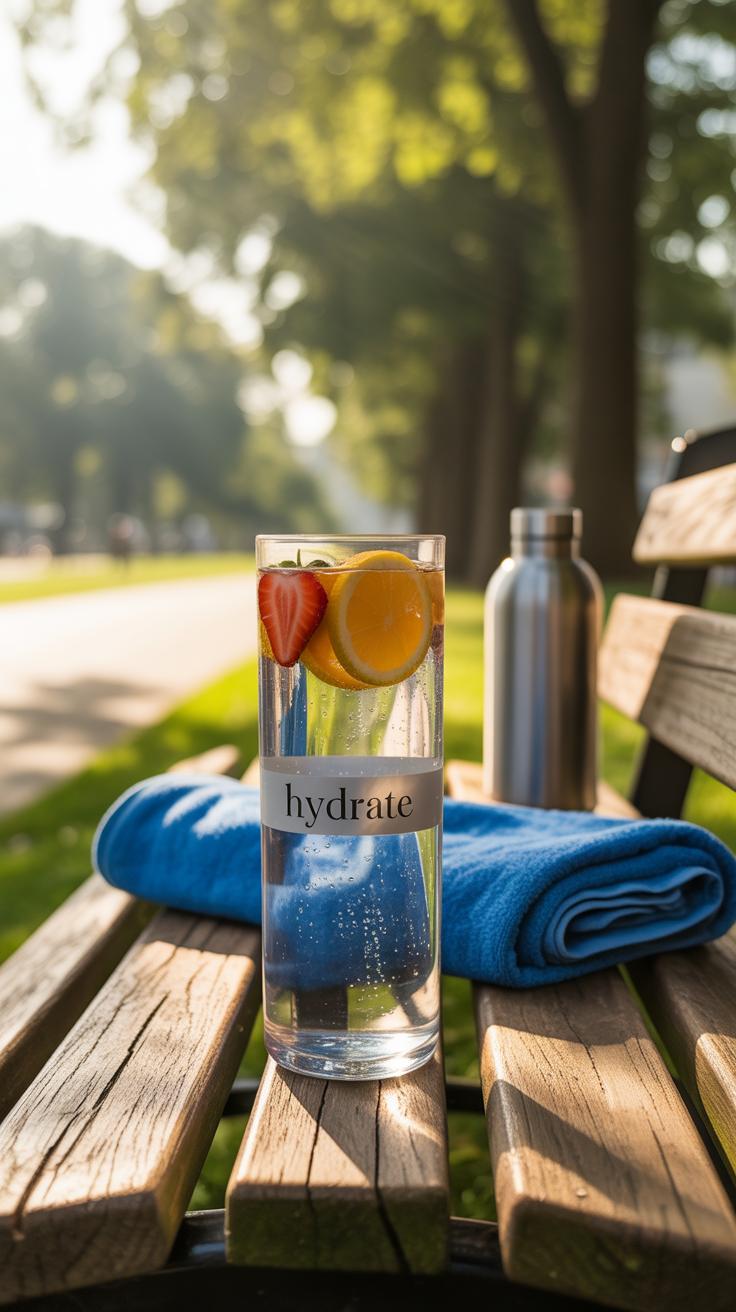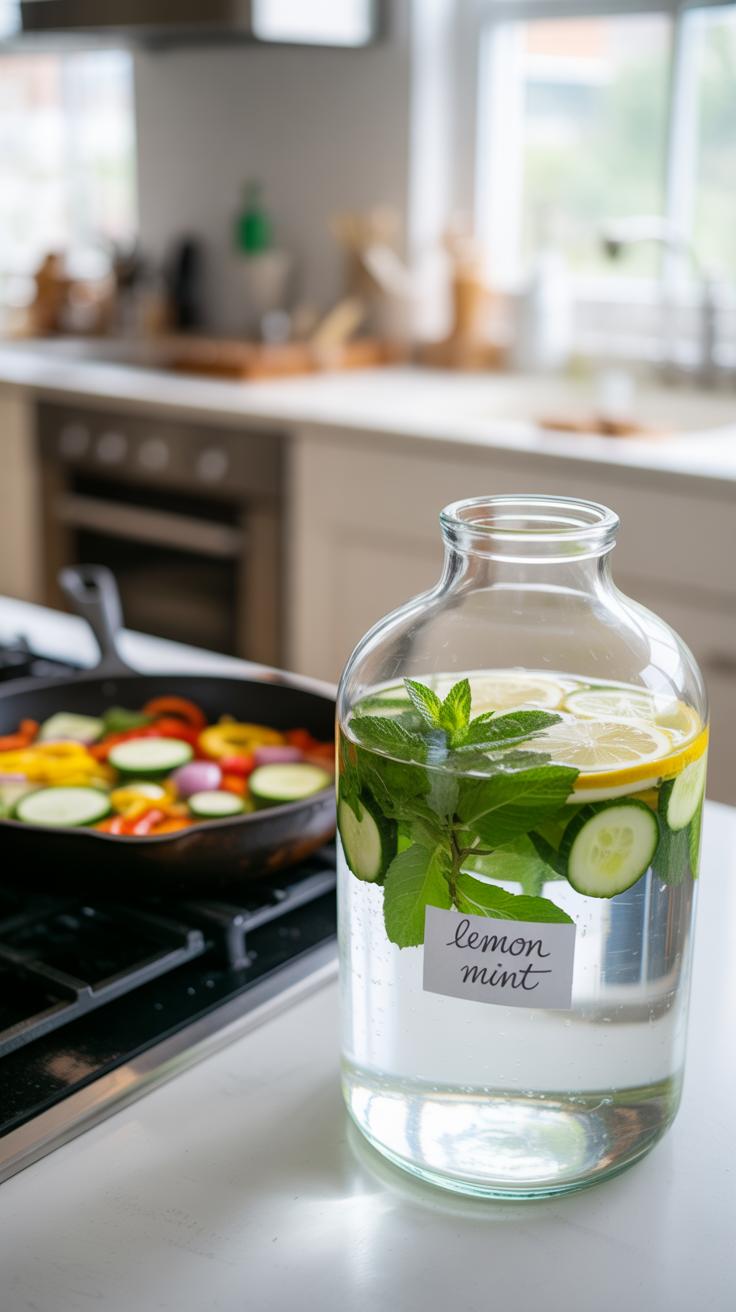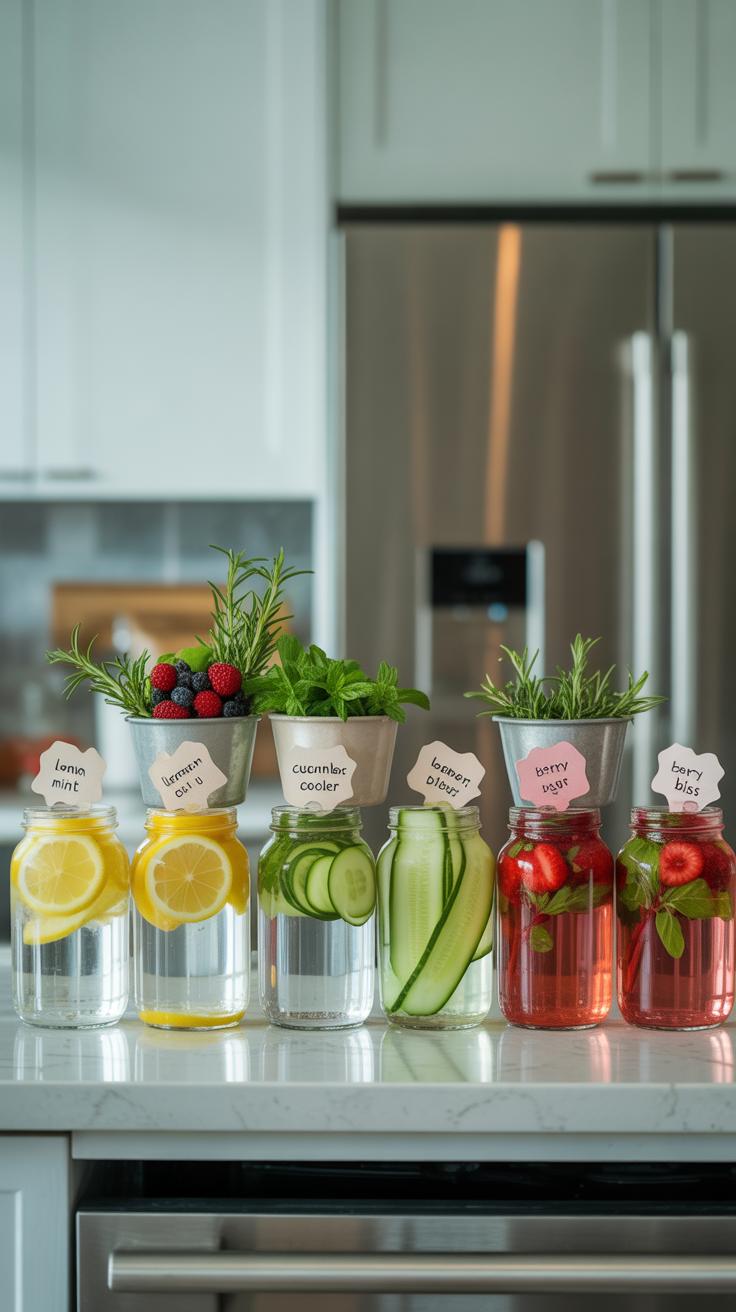Introduction
Delicious Infused Water Recipes To Keep You Hydrated offers a tasty way to enjoy water while adding natural flavors and nutrients. Infused water is made by soaking fruits, herbs, or vegetables in water to release flavors and benefits. It turns plain water into a refreshing drink that encourages you to drink more throughout the day.
This article explores different recipes and ideas for infused water. You’ll learn how to mix ingredients for the best taste and health benefits. Whether you want detox benefits, vitamin boosts, or just want to enjoy a fun drink, these recipes are easy to make and enjoy anytime.
What is Infused Water and How Does it Work
Infused water is simply water that’s been flavored by soaking fruits, herbs, or vegetables in it for a period of time. The process seems straightforward, but the way those flavors and nutrients seep into the water is a bit more interesting. When you leave fresh ingredients in water, some of their natural compounds—like vitamins, antioxidants, and essential oils—start to dissolve out.
Take a lemon slice, for example. As it sits, its citric acid, vitamin C, and aromatic oils slowly mingle with the water. The same goes for herbs like mint; their refreshing oils spread, subtly changing the water’s taste without overpowering it. So, you’re not just drinking plain water—you’re sipping on a gentle extraction of what’s inside fresh produce. But it’s not just flavor; these nutrients can offer some benefits, though how much depends on how long you infuse and which ingredients you pick.
It’s a bit like brewing tea, but colder, fresher, and more about gentle soaking than steeping. Oddly enough, the textures don’t transfer—your water stays clear and drinkable while carrying hints of whatever you put in. And the best part? You control exactly what goes in, no added sugars or artificial things needed.
Benefits of Drinking Infused Water
Drinking infused water nudges you to drink more fluids because it feels less boring than plain water. Sometimes plain water just doesn’t excite—do you feel this too? Adding subtle flavors without sugar helps you stay hydrated more easily. That extra hydration can improve energy levels, skin health, and digestion, even if it sounds a bit cliché.
You also get tiny boosts of vitamins and antioxidants, depending on your ingredients. For instance, citrus fruits can add small amounts of vitamin C, while cucumber might offer hydration support with silica content. Herbs like basil or rosemary may contribute antioxidants, but don’t expect massive doses. Still, even these minor nutrients complement your daily intake and keep your water drinking interesting.
Some people notice fewer cravings for sugary drinks when they switch to infused water, which feels like a plus though it varies from person to person. The combination of hydration and mild flavor can subtly shape better habits without demanding much effort.
Basic Infusion Tips
Here are some practical pointers to keep in mind. Use fresh, preferably organic ingredients if you can. Freshness impacts flavor and nutrient content more than you might expect. Cut fruits and veggies into thin slices or small pieces to help release their flavors quicker.
Soaking time depends on taste preferences: around 2 to 4 hours at room temperature usually works, but you can chill the infusion overnight for a stronger taste. Just don’t wait too long—more than 24 hours can start to taste bitter or stale.
Store infused water in the fridge to keep it fresh longer. Glass containers are ideal, as plastic may absorb flavors or affect taste. Also, consume the water within 48 hours for the best experience, although it’s tempting to keep it longer.
If you want a stronger flavor, consider muddling herbs gently before adding. But don’t overdo it, or the taste may get overpowering. Overall, infused water is flexible. Try different combos and see what feels right.
Easy Citrus Infused Water Recipes
Citrus fruits have this natural brightness that makes water feel… alive, I guess. Using lemon, lime, or orange can lift your hydration routine without much fuss. If you’re looking for simple but fresh, these recipes might do the trick.
Classic Lemon and Mint Water
To make lemon and mint infused water, start by slicing one lemon into thin rounds—no need to peel it because the zest adds a nice bite. Grab a handful of fresh mint leaves and gently crush them to release their oils. Toss everything into a pitcher, then fill it with cold water.
Let it sit in the fridge for at least an hour to let those flavors mix—an hour, maybe two, if you want it stronger. I usually keep a jug of this around, and I notice it feels cleaner and more refreshing than plain water. You can adjust the mint amount based on how herbal or mild you want the taste.
Combination of Orange, Lime, and Basil
Mixing orange, lime, and basil sounds like a bit of an unexpected trio, right? But it works mostly because each element brings something different. Slice half an orange and one lime, then add them to your water jar. Add several fresh basil leaves—don’t chop them; tearing works better—and gently bruise them to unlock that subtle aroma.
Give it a gentle stir and chill it for about an hour. The water ends up somewhat citrusy but with this soft, almost peppery twist from the basil. Imagine something that you don’t quite expect but enjoy once you notice it. If you like it zesty, add a few more lime slices. This is one I turn to when I want something lively without going over the top.
Fruity Summer Infused Water Ideas
Mixed Berry Infused Water
Using fresh berries in your infused water can turn plain hydration into something a bit more tempting. Start with a handful of strawberries, blueberries, and raspberries. You don’t need to slice the blueberries or raspberries, but cutting strawberries into halves or quarters helps release their flavor more quickly.
Put the berries in a pitcher and fill it with cold water. Let it sit in the fridge for about two hours—longer if you prefer a stronger taste. I find that after around four hours, the water gets a nice balance of subtle sweetness without being overpowering. You could add a few ice cubes before serving to keep it chilled on a hot day.
Sometimes, I wonder if muddling a few berries lightly could boost the flavor, but it’s easy to overdo it and end up with cloudy water. So, I usually avoid that step unless I’m in the mood for a bit of mess.
Watermelon and Cucumber Coolers
When the sun is really beating down, this combo feels like a small relief. Dice fresh watermelon into cubes and slice cucumber thinly. Toss them into a big jar and cover with cold water. The watermelon gives a hint of sweetness, while cucumber adds a crispness that doesn’t feel heavy.
Leave your watermelon and cucumber water in the fridge for at least an hour before drinking—sometimes I forget and it’s still quite refreshing, just less infused. For a personal touch, try adding a small sprig of mint or a squeeze of lime. It’s not necessary, but it can elevate the drink in unexpected ways.
You might think this sounds simple, but it’s surprisingly good. Plus, it’s mostly water with a bit of flavor, resisting the urge to turn into something sugary or artificial. You get the hydration you need, made flavorful by nature itself.
Herbal Infused Water Options
Herbs like mint, rosemary, and lavender offer more than just subtle flavor boosts to your water—they can shift the whole experience of hydration. Mint, for instance, brings a cool, refreshing taste that almost wakes you up with every sip. Rosemary, on the other hand, adds an earthy, slightly piney note that feels grounding, and lavender lends a floral calmness that’s almost soothing just by smelling.
Besides taste, these herbs come with natural benefits, like mint’s ability to ease digestion or lavender’s mild calming effects. That said, the strength of herbal infusions depends a lot on how long you let them sit and how fresh the herbs are. Sometimes you want just a whisper of flavor, other times it’s okay if it’s a bit strong—so play around.
Refreshing Mint and Lime Water
For this one, grab some fresh mint leaves—maybe a handful—and a lime. Slice the lime thinly. Drop the mint and lime slices into a pitcher or a large bottle. Press them lightly, but avoid bruising too much unless you want it stronger. Fill the container with cold water, then chill it for at least an hour. The citrus and mint balance each other out nicely; you get that crisp zing from lime with the coolness of mint. It’s simple, but surprisingly refreshing, especially when it’s hot out.
Lavender and Lemon Infusion
Lavender’s trickier—you don’t want to go heavy-handed. Start with a teaspoon of dried lavender buds or a few sprigs of fresh lavender. Add thin slices of lemon, maybe half a lemon worth. Combine these in water, and let it steep in the fridge for about two hours. The flavor turns out gentle but effective, a little floral, with just a touch of citrus brightness. It’s perfect when you want something calming, maybe in the evening when you’re winding down. You might find it’s subtle enough to sip any time, though—it depends on your taste.
How to Make Infused Water for Detox
Cucumber and Lemon Detox Water
If you’re aiming to gently flush out toxins, cucumber and lemon water is a popular choice—and for some good reasons. Both ingredients encourage hydration, but they also bring subtle cleansing properties to the table. To make this detox water, slice half a cucumber and one lemon into thin rounds. Drop them into a large pitcher filled with cold water—about 1 to 1.5 liters works well.
Let the mixture steep for at least 2 hours in the fridge, though some prefer to leave it overnight. The longer it sits, the more flavors—and benefits—you’ll draw out. Cucumber has antioxidants that may help soothe inflammation, and lemon’s natural acidity is thought to support digestion. It’s a mild cleanse, and sometimes I find myself sipping it just because it feels refreshing, not necessarily because I’m in detox mode.
Try to drink this throughout the day rather than all at once. It’s not a quick fix but more of a gentle assist in keeping your system balanced.
Ginger and Mint Cleanse Water
Ginger and mint provide a lively combo for detox water that wakes you up a little while helping your system along. Fresh ginger’s bite may ease digestion and reduce nausea, and mint adds that cooling touch, which makes the water extra pleasant to drink—especially on a warm day or after a heavy meal.
To prepare, peel and thinly slice a thumb-sized piece of fresh ginger. Add it to about a liter of water along with a handful of fresh mint leaves, torn slightly to release their aroma. Let it infuse for about 3 hours in the fridge—this timing seems just right for a clear ginger flavor without overpowering.
Sometimes, I struggle with drinking enough water, but this blend makes hydration feel less like a chore. It’s subtle yet effective. You might wonder if it actually detoxifies—well, it may not be dramatic, but incorporating ginger and mint can support your digestive system and make the whole detox experience more enjoyable.
Boosting Energy with Infused Water
When you feel that mid-afternoon slump or need a quick pick-me-up, infused water with citrus and herbs might be just what your body craves. These ingredients don’t just add flavor—they can help sharpen your focus and give you a subtle energy lift, without the jitters you might get from coffee or energy drinks.
Take citrus fruits for example. They carry natural vitamin C, which supports your adrenal glands and can help you feel more alert. Then add a herb like rosemary, known for its potential to improve concentration and reduce fatigue. Together, they make a blend that feels refreshing but also oddly invigorating.
Citrus and Rosemary Energy Drink
Try this simple recipe: slice up a lemon and an orange. Throw in a few sprigs of fresh rosemary into a jug of water. Let it steep for a couple of hours, or overnight if you prefer a stronger taste. Rosemary’s piney notes balance the bright citrus flavors in a way that wakes up your senses slowly, without overwhelming them.
I’ve found this infusion perfect for mornings when I want something light but sustaining. The rosemary seems to nudge my brain into gear, while the citrus keeps me feeling fresh rather than drained.
Green Tea Infused Water
If you want something a bit different, infuse cold water with lightly brewed green tea—steep a green tea bag for just a couple of minutes to avoid bitterness. Then add a few thin slices of lemon. The caffeine and antioxidants in green tea provide a gentle boost, while the lemon brightens the flavor and adds a bit of zing.
This infusion works well when you want to hydrate but also need some mental energy. It’s less about a sugar rush and more about sustained alertness. Sometimes, I wonder if the ritual of making this infusion helps as much as the drink itself. Either way, it’s an easy way to keep your energy steady during a long day.
Infused Water for Kids
Getting kids to drink enough water can be tricky. But making it fun and tasty often does the trick. One idea that usually works well is fruity rainbow water. You take clear water and add layers of colorful fruits—strawberries, oranges, kiwi, blueberries, maybe grapes. Layer them carefully in a clear bottle or jar, so the kids can see each color shining through. It’s almost like edible art, which makes kids curious enough to take a sip. You might need to remind them it’s okay to drink it even if it looks pretty enough to keep as decoration.
Another simple recipe that tends to be a favorite is apple and cinnamon infused water. Slice some sweet apples and add a couple of cinnamon sticks to cold water. Leave it in the fridge for a few hours. The warming scent of cinnamon blends beautifully with the apple’s natural sweetness, creating a comforting drink that doesn’t feel like plain water. Some kids might even find it reminds them of fall or holiday treats. It’s subtle but inviting, and does a good job of encouraging hydration without overwhelming their taste buds.
Both recipes are easy to prepare and offer a way to sneak vitamins from fruits into a daily routine. Plus, shaping the fruits in fun styles—like stars with cookie cutters or hearts—adds a little magic some days might need. Have you noticed how kids often respond better when their drinks look colorful or playful? Sometimes it feels less like a chore and more like a small delight, which might be exactly what keeps the water glass full.
Using Infused Water in Cooking
Salad Dressings with Infused Water
Infused water can add a subtle twist to your homemade salad dressings. Instead of plain water or vinegar, try using citrus or cucumber-infused water for a lighter, more refreshing base. For example, a lemon and mint-infused water works well when mixed with olive oil, a splash of vinegar, and a pinch of salt.
You might find that the infused water gives your dressing a more delicate flavor, making it less sharp but surprisingly complex. It’s not always possible to get the exact intensity you want on the first try, so experimenting with different infusions—say, grapefruit and rosemary or strawberry and basil—can really elevate your greens.
This approach also reduces added sugars and artificial flavors. Plus, it’s an easy way to stretch out strong ingredients without watering down taste. I often add a touch of honey or mustard to balance acidity when using infused water in dressings. Would you try replacing plain water in dressings with an infused version? It might become your new go-to for fresh salads.
Infused Water in Fruit Sorbets
Fruit sorbets can benefit a lot from infused water. Instead of using plain water or juice alone, try incorporating infused water to subtly boost flavor complexity without extra sweetness. For instance, blueberry and lavender-infused water adds a nice floral note that pairs well with berries in sorbet recipes.
When making sorbets, the flavored water helps keep the final texture smooth and light, while layering in a hint of herb or fruit essence. You don’t need strong infusion either; a gentle touch works best because freezing tends to concentrate flavors.
I recall making a grapefruit and thyme sorbet using infused water, and it turned out surprisingly fresh, without the overpowering bitterness sometimes found in citrus desserts. Maybe the trick is balancing your infused water’s strength with the natural fruit base. If you like, add a bit of lemon juice or agave to tweak sweetness while keeping that unique infusion taste.
Have you ever considered how infusion can replace part of the liquid in frozen treats? It’s a simple, clever way to add layers of flavor you might not expect initially.
Storing and Serving Infused Water
Proper Storage Techniques
Storing infused water properly can really make a difference in taste and freshness. Ideally, keep it in the fridge right after preparing. Cold slows down any flavor changes and prevents the fruit or herbs from going off too quickly. Glass containers are usually best—they don’t absorb odors and retain the water’s purity better than plastic.
Water infused with soft fruits like berries or herbs tends to lose its brightness faster, so try to consume it within 24 to 48 hours. Citrus-infused water sometimes lasts a bit longer, maybe up to three days, but even then, fresh is best. If you leave it out for hours on the counter, the flavors can become muddled or even sour.
I’ve sometimes wondered if leaving the fruit or herbs in the water after infusion helps or harms the taste. To be honest, removing them after a few hours seems to keep the flavor stable without turning bitter. But this can depend on personal preference and the ingredients used.
Serving Ideas and Presentation
How you serve infused water can make it feel more special—like a treat rather than just hydration. Fancy glassware helps, but you don’t need anything too elaborate. Tall clear glasses or mason jars emphasize the colors and make the ingredients visible, which is part of the appeal.
Adding a few fresh garnishes just before serving—like a sprig of mint, a thin slice of lemon, or even edible flowers—can revive the aroma and appearance. They can refresh the drink visually and boost its appeal, especially on a warm day.
What about ice? Sometimes I add crushed ice to keep it extra cold without watering things down too fast. Alternatively, frozen fruit cubes work well—they don’t dilute the flavor and add a subtle chill.
Ultimately, serving infused water is about making a small moment of daily hydration feel a bit more intentional. Maybe try a different type of glass or a new garnish next time you pour yourself a glass and see if it changes how you enjoy it.
Common Mistakes to Avoid
Using Old Ingredients
Freshness really makes a difference when preparing infused water. Using fruits or herbs that are past their prime can change the whole experience—not in a good way. I once tried to save some slightly wrinkled lemon slices, thinking they’d be fine, but the water tasted dull and a bit off. Stale ingredients lose their flavor and sometimes add unwanted bitterness or even moldy notes. There’s also a small chance bacteria could multiply if the ingredients aren’t fresh, so it’s safer to use freshly picked or recently bought produce.
To avoid this, always inspect each piece before adding it. Fresh herbs should look vibrant and feel firm, not wilted or slimy. Fruits need a bright color and no mushy spots. Sure, it might feel wasteful to toss out less-than-perfect pieces, but your infused water will thank you—and so will your body.
Over-infusing and Flavor Balance
It might be tempting to leave your ingredients in for hours or overnight, thinking the flavor will get stronger. But that’s where things can go wrong. Over-infusing often results in an overpowering, bitter flavor, especially with herbs like mint or rosemary. Citrus peels, if left too long, can turn sharp and dominate the entire drink. It’s a delicate balance.
Finding the right infusion time depends on the ingredients. For example:
- Soft fruits like berries or cucumber usually need shorter times—around 1 to 2 hours.
- Harder ingredients like ginger or citrus slices might take 3 to 4 hours.
- Herbs vary—mint can be quick, while rosemary often needs more but risks bitterness.
If you’re unsure, start with smaller amounts of ingredients and check the flavor every hour. That way, you won’t risk overdoing it. Remember, you can always add more if needed, but it’s hard to fix an overly intense flavor once it’s there. Sometimes less is more, and letting water hydrate your palate slowly actually feels better after a while.
Conclusions
Infused water makes drinking water exciting and healthy. By mixing fruits, herbs, and vegetables, you can create many tasty drinks that fit your favorite flavors and keep you hydrated. It’s a simple change that helps you drink enough water every day.
Try different combinations to find what you like. Use fresh ingredients and prepare infused water at home for a fun, healthy habit. Drinking infused water supports your body with natural flavors and can improve your well-being. Start today and enjoy healthy hydration with every sip.

